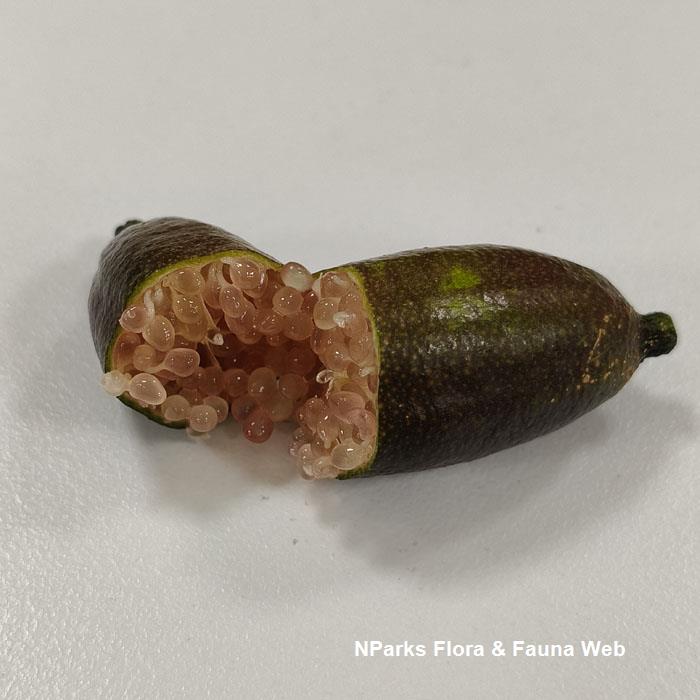
Name
Classifications and Characteristics
| Plant Division | Angiosperms (Flowering Seed Plants) |
|---|---|
| Plant Growth Form | Tree, Shrub |
| Lifespan (in Singapore) | Perennial |
| Mode of Nutrition | Autotrophic |
| Maximum Height | 6 m |
Biogeography
| Native Distribution | Australia |
|---|---|
| Native Habitat | Terrestrial |
| Preferred Climate Zone | Tropical, Sub-Tropical / Monsoonal |
| Local Conservation Status | Non-native (Horticultural / Cultivated Only) |
Description and Ethnobotany
| Growth Form | It is a shrub or a small tree up to 6 m tall. |
|---|---|
| Flowers | Flowers are tiny, pinkish outside and white inside, slightly fragrant. |
| Fruit | Its fruit have distinctive finger shape and change from green to variable colors when mature. Numerous semi-transparent juice vesicles are enclosed in the fruit. Juice vesicles are rounded and separated from each other, resembling the caviar. |
| Ethnobotanical Uses | Edible Plant Parts : Edible Fruits Food (Fruit or Vegetable): The fruit pulp can be used in seafood or as garnish in salad and desserts. The rind can be processed into spice. |
Landscaping Features
| Desirable Plant Features | Ornamental Fruits |
|---|---|
| Landscape Uses | Parks & Gardens |
| Usage Hazard - Cons | Spines/Thorns - Stem/Branch |
Plant Care and Propagation
| Light Preference | Full Sun |
|---|---|
| Water Preference | Moderate Water |
| Plant Growth Rate | Fast to Moderate |
| Rootzone Tolerance | Well-Drained Soils |
| Propagation Method | Seed, Grafting |
Foliar
| Mature Foliage Colour(s) | Green |
|---|
Floral (Angiosperm)
| Flower Colour(s) | White |
|---|
Fruit, Seed and Spore
| Mature Fruit Colour(s) | Green, Pink, Purple, Red |
|---|---|
| Mature Fruit Texture(s) | Rough |
Image Repository
Others
| Master ID | 33741 |
|---|---|
| Species ID | 8155 |
| Flora Disclaimer | The information in this website has been compiled from reliable sources, such as reference works on medicinal plants. It is not a substitute for medical advice or treatment and NParks does not purport to provide any medical advice. Readers should always consult his/her physician before using or consuming a plant for medicinal purposes. |





s.jpg)


